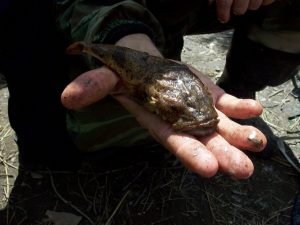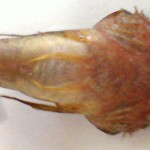Haitej sculpin (Mesocottus haitej)
Genus Mesocottus. Gratzianow, 1907.
One very strong sharp spine on the preopercle; three more spines below it. Two very weak longitudinal crests extending behind the eyes on the occiput; a smaller crest on the outer side of each of the above, excending in the pteroic region. A weak crest on the ossicle running across the cheeks to the preopercle. A similar crest on the upper portion of the opercular bone. Head covered above with epithelial tubercles. Jaws and vomer toothed. Branchiostegal membranes grown to the wide isthmus, but the suture (a barely visible plica) can be observed at the place attachment. Postcleithrum present. Close to the Japanese and Chinese Trachidermus, but has no palatine teeth. A single species in the Amur basin.
Mesocottus haitej. Dybowski,1896. Cottidae. Benthopelagic; freshwater.
Synonym, Cottus haitej.
Terra typica; River Onon, Dauria (province), Russia ca. 51° 42’ N, 115° 50’ E
Description. D1 VIII IX; D2 12-15; P 16-17, A 10-13; VI 3-4; C I,10,I. In the lateral line 35 pores. Gill rakers 4-6, in the form they tubercle-like, covered with small spinulets. Pyloric caeca 5. Vertebrae 32-33 . Body spindle-shaped it gets narrow evenly from the head to the tail. The skin is thick, densely covered with bony spines that are not only on the ventral side of the body. Caudal peduncle short. The back and sides are gray, sometimes brownish. The abdomen is brighter, for the first dorsal fin and the base of the tail, there are 3 dark stripes that extend up the sideline (and partly below). Caudal fin rounded. P, D and C with rows of dark speckles, the pectoral fins fully developed, ending in a vertical first rays D2. The males have larger pectoral fins than the female and are more brightly colored. Pelvic fins rather short, not reaching vent. Dorsal fins meeting or slightly separated . Anal fin shorter than D2, but the same height with him and starts behind the vent. The head is very big and broad, strongly armed, preoperculum 4 well developed spine, upper spine is very sharp, suboperculum with a blunt spine. Mouth large, jaws equal in length and reach the vertical middle of the eye. Dental lamina poorly differentiated, the teeth villiform located in the middle of the jaws, larger than all the rest. Eyes small, interorbital space broad. Anterior nostrils are flattened as short tubules tapering upwards and the posterior nostrils are in the form of pores. Nasal spines absent. Seismosensory system is represented by narrow canals that open outward with small pores; the sensory canal passing in the preopercle occupies about 14% of its width. On the chin has 2 pores. The lateral canal is complete and in the middle of the trunk. The maximum age of 5 years, reaches a lenght of 20 cm SL. Subspecies are not.
Distribution. Found in Russia, Mongolia (Onon River), North China (Wudalianchi Lakes) and North Korea (Yalu River). In Russia, lives in the basin of the Amur River from the headwaters (River Shilka, Argun, Onon, Ingoda) to the estuary, there is in the basins of the Ussuri and the Songhua River. Lives in the Amur Liman, Tartary Strait and rivers northern Sakhalin Island ( River Tym’, Teńgi).
Lifestyle. In the main river current, leading a sedentary lifestyle bottom. Lives mainly in the river, holding the pebble, rarely sandy bed. In the food composition comprises the larvae of mayflies, stoneflies, caddis flies and midges, mysids, gammarids and fish (stickleback, minnow and bitterling). In young fish, the length of 50-60 mm are more common chironomids, the larger specimens is dominated by the larvae of mayflies. At the age of 1+ has a length of 65 mm, 2+ – 115 mm, 3+ – 145-150 mm, and 4+ – 160 mm and weight ca. 85 g . Matures in the third year of life in the length of 10-11 cm. Fertility, defined by one specimen, amounted to 2.822 eggs. Spawning takes place in May-June at water temperatures of 10-16 °C .
Aquarium. This is a typical cold water fish and does not like temperatures that exceed 20° C. There fish are rarely kept in captivity since they need cold, clear water nearly saturated with oxygen. Their diet is primarily animal matter. Longevity under proper conditions is up 4 years (reaching 10 cm). Water conditions; temperature 1-14° C, pH 6,5; 4-25°dH.


Links:
http://archive.org/stream/zapiskiimperator24stpt#page/216/mode/2up
http://www.archive.org/stream/zoologischeranze311907caru#page/660/mode/2up
http://www.sevin.ru/vertebrates/index.html?fishes/267.htm
http://www.burges.rushydro.ru/upload/iblock/b8e/Fish-min.pdf
http://www.club-mayak.ru/forum/viewtopic.php?f=90&p=148313
http://fishery.agridata.cn/detail.asp?db=FishData&table=A040201&id=1063
http://ibss.febras.ru/files/00006686.pdf
http://www.biologiezentrum.at/pdf_frei_remote/VZBG_19_0945-0958.pdf
http://www.archive.org/stream/rybypriesnykhvod00berg#page/434/mode/2up
http://www.archive.org/stream/notizenberdief00varp#page/18/mode/2up
http://lin.irk.ru/pdf/3029.pdf
http://www.biodat.ru/db/areal/areal.php?fil=7
http://www.wwf.ru/data/publ/amur/book_amur_vkladka_wwf.pdf
http://tinro.khv.ru/amurfishes/cottus.htm
http://old.zabspu.ru/science/records/egf.pdf
http://siteresources.worldbank.org/INTEAPREGTOPENVIRONMENT/Resources/fishes_of_mongolia.pdf
http://forum.vitawater.ru/forum/112790/amurskii-akvarium?page=6
http://amur-heilong.net/pho/03_species/fish/fishspecies/index.html
http://www.teleport2001.ru/teleport2001-ru/2012/06/29/10703.html



